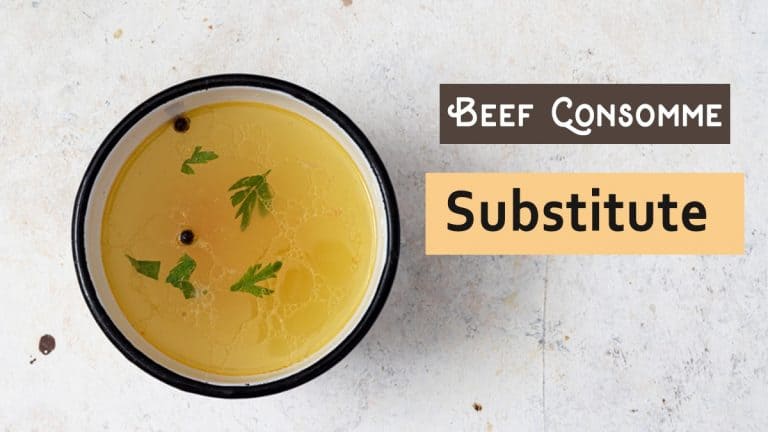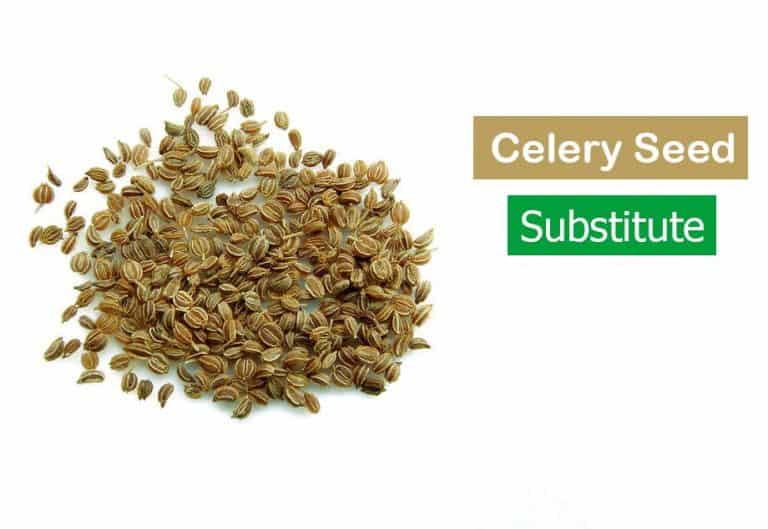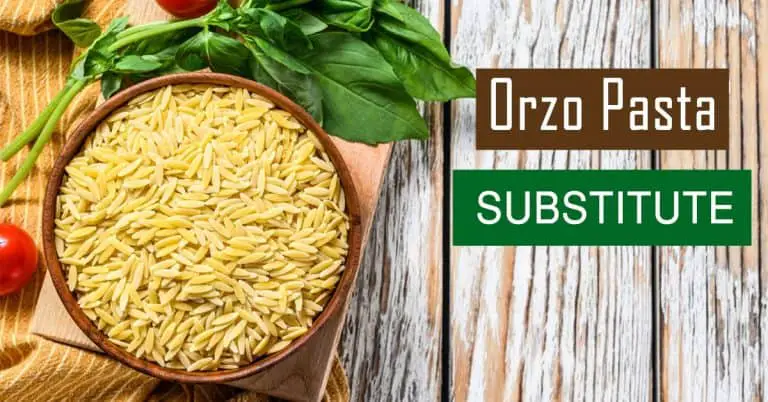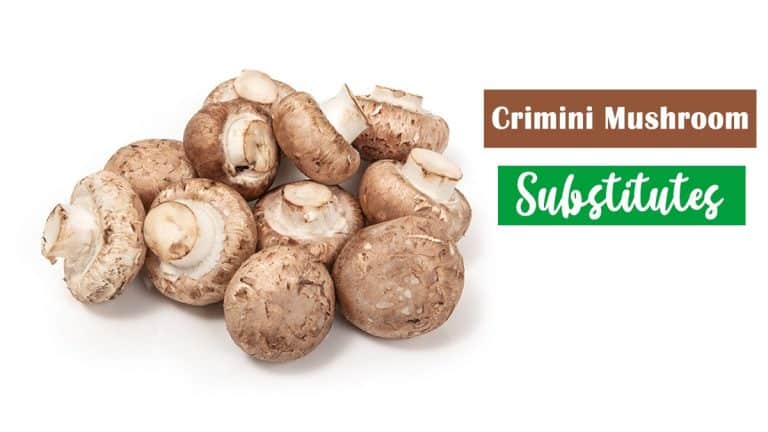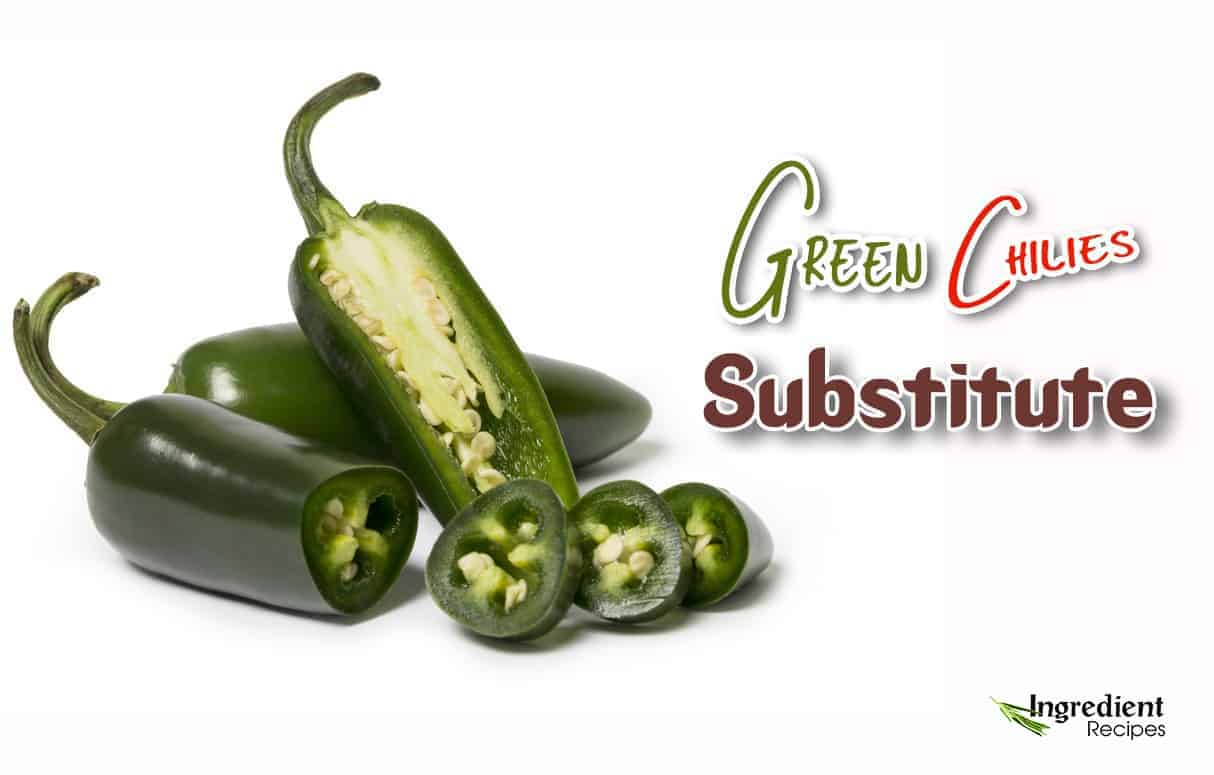
Green chili has been the secret behind many legendary recipes for thousands of years. However, it’s not always the case that you can find them, this calling for a good green chilies substitute in those times.
Below, we will disclose the best choices, all of which share a certain level of similarity with green chilies.
Top 12 Substitutes for Green Chilies
1. Banana Pepper
If it’s the smokiness that you are after, there is no way you can overlook the banana pepper. This medium-sized chili pepper is typically in bright yellow. Of course, there is still a chance of them changing color to orange, red, or green while ripening.
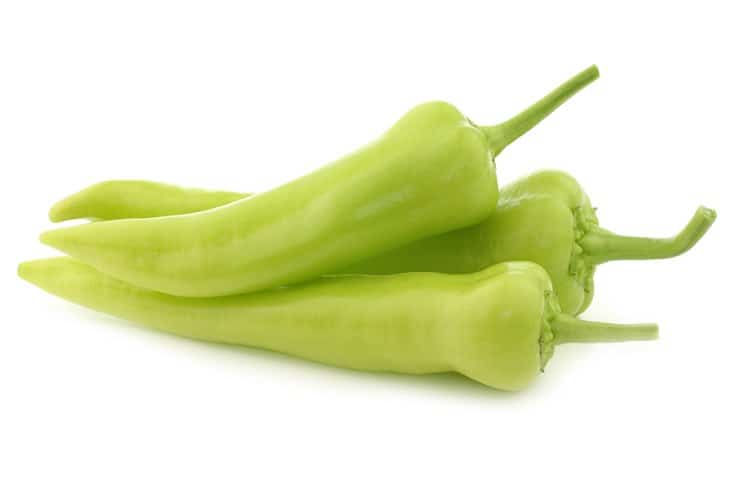
A fully mature banana pepper can reach 2 or 3 inches long with a curved shape. They share some similarities in appearance with bananas, hence the name. This cultivar of the Capsicum annuum species is not known for its spiciness, scoring less than 500 Scoville scale.
Banana pepper is famous for a mild and tangy taste instead, which many have described similar to green chilies. The riper the pepper gets, the sweeter it becomes. That is exactly why you will see them as a substitute for green chiles in loads of Indian food.
You can also slice them up and use them to garnish sandwiches and pizzas the same way you use green chiles. However, the best use is to combine them with Feta cheese, cherry tomatoes, and cucumbers for an incredible Greek salad.
Banana peppers are rich sources of vitamin C, which is known for its blood pressure controlling capability. There is also a high concentration of vitamin B6, which improves the production of serotonin and dopamine.
2. Anaheim Pepper
If you cannot find any green chili near your place, one of the best substitutions you can count on is the Anaheim pepper. There simply is no way that your local market doesn’t have it, as it is among the most common peppers across the U.S.
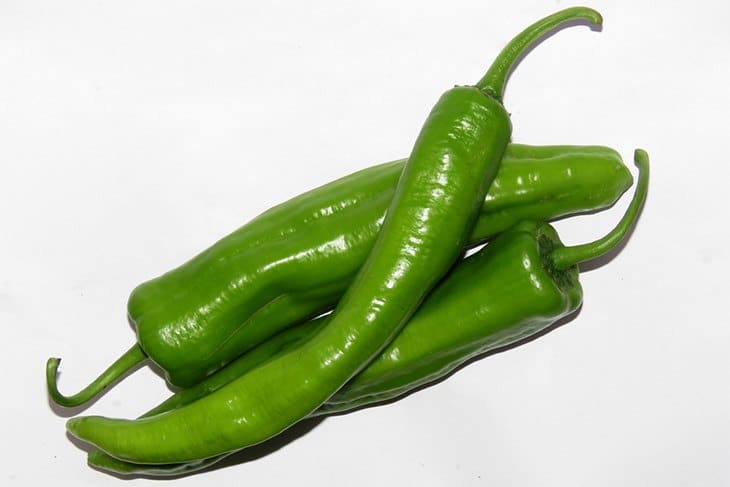
With just one look, you will easily distinguish this pepper, thanks to its length and color. A ripen Anaheim pepper is typically between 6 and 10 inches long with a dark green color.
Originating from New Mexico, this pepper was brought into southern California’s Anaheim city in 1894 by Emilio Ortega. Ever since its debut, it has remained a highly popular ingredient for all types of American meals.
The reason for this popularity is the versatile nature and medium heat of this chili. You can do pretty much anything you want with it, especially interchanging them with green bell peppers. For instance, they can replace green chili in your Cajun Holy Trinity or even your mirepoix, providing less of a head kick.
We do believe, however, that the best way to prepare Anaheim peppers is to roast them due to their thicker flesh. If you can stuff them with some cheese before roasting, you will have an incredible substitute for the classic chiles Rellenos.
3. Poblano Pepper
We have here one of the more known Mexican peppers; you can also call it Poblano chile ancho or simply ancho. As ancho is the Spanish word for “wide,” one can easily guess that a clear characteristic of this pepper is its wide body.
True to that notion, a Poblano pepper can reach at least 2 inches in width and 3 inches in length. These almost square-shaped peppers have a green with a tint of dark purple color while still immature. The mature ones will eventually redden so much that they nearly become black.
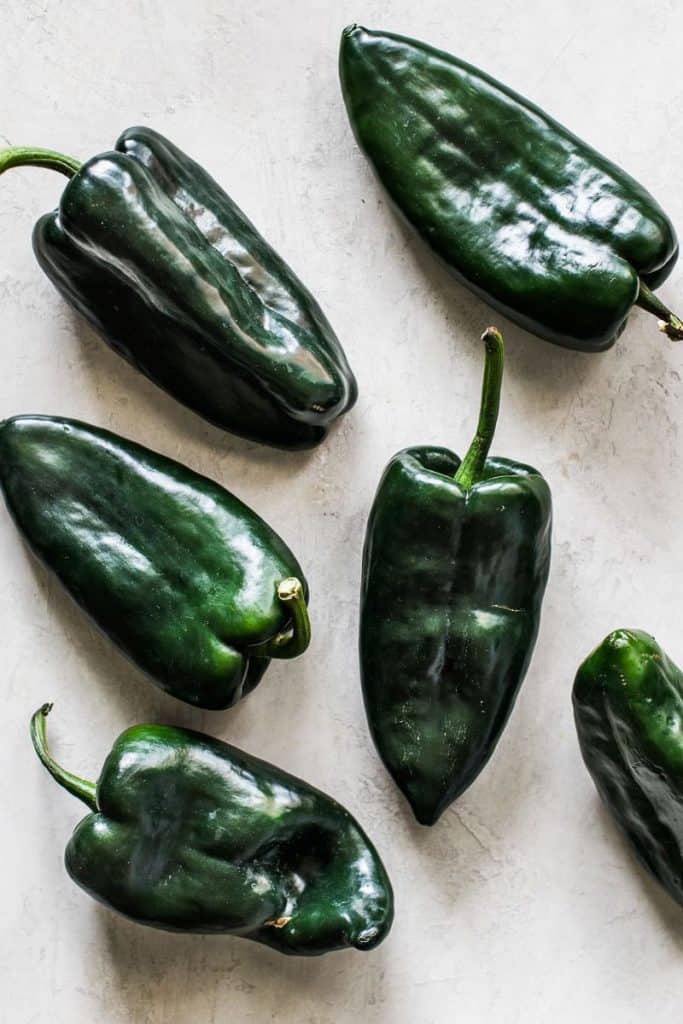
Poblano peppers offer a musky, sweet flavor after you roast them, proving a great substitution for green chillies. If you are craving some Indian cooking style of deep-fried green pepper, you can try out roasted Poblanos. There simply is no noticeable difference between the two.
You can also slice them lengthwise to replace diced green chiles in your favorite recipes like stir-fries or meat dishes. This type of pepper has quite a huge carotenoid percentage. As a result, they are incredibly good at fighting inflammation.
4. Pasilla Pepper
Also known as “little raisin,” Pasilla is the dried form of the chilaca pepper or pasilla bajio.It rarely ever happens that you can’t replace green chiles with fresh Pasilla pepper, but the dried form application might be more limited. Pasilla peppers are typically so dark they are almost black in color due to the drying process.
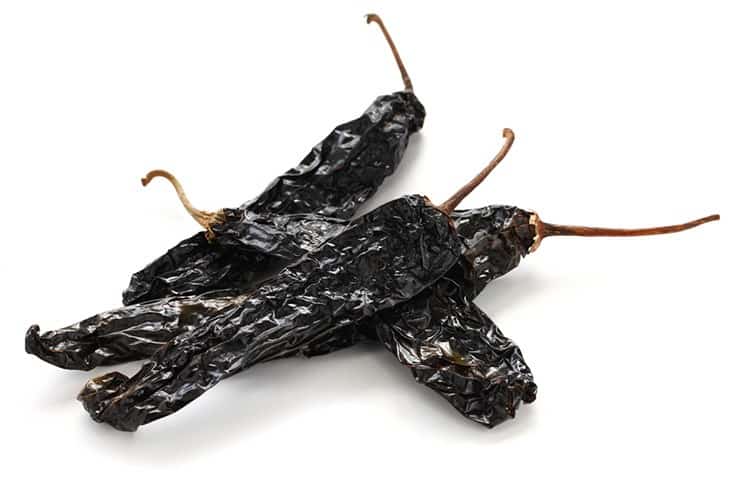
This pepper is one of the Mexican chile pepper’s “holy trinity,” alongside guajillo pepper and ancho pepper. It has a distinct earthy flavor and smoky taste, creating an interesting twist for many dishes. The most popular method of utilizing Pasilla is to grind them into powder and make sauces.
This pepper is completely interchangeable with green chili paste in paste form, as they imbue the same smoky taste. That is why many people who are not good with intense heat use them instead for dishes like salsas, moles, and chili paneer.
Pasilla pepper will provide your body with a healthy amount of vitamin B2. This vitamin is especially good at metabolizing energy to maintain conventional digestive, nerve, hormone, and brain function.
5. Green Fresno Pepper
You can also know it under the name chile Cera or chile caribe. This pepper is the invention of Clarence Brown, who gave it the name “Fresno” to honor Fresno, California. Ever since its introduction back in 1952, this pepper has become one of the most popular ingredients across America.
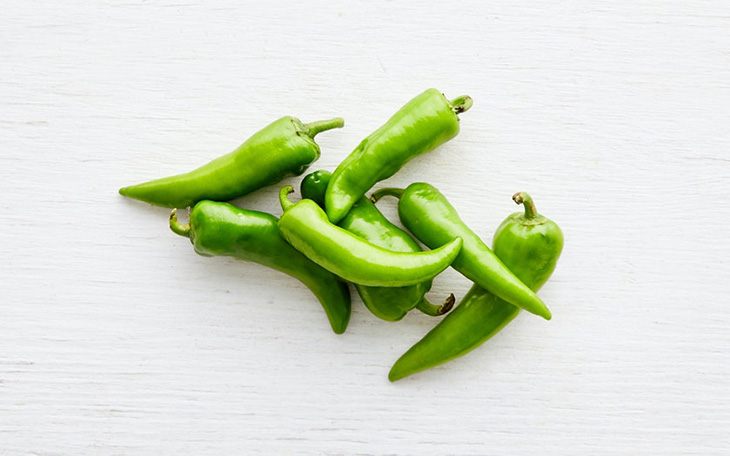
The green Fresno has a slightly glossy green color, which you will immediately recognize with just one look. This wax-type pepper has a conical shape narrowing down to a point. Its flesh is also among the thickest, making it completely unable to dry properly.
Most people use green Fresno chili to make spicy pickles. After all, its pickle form is not as hot but has the same earthy taste as pickled green bell pepper. It can also add in the same spiciness that green pepper is known for into stews and casseroles.
Aside from the obvious supply of vitamin A, green Fresno chiles also give you a significant amount of niacin, iron, and thiamin. As such, people with a high cholesterol level will appreciate some green Fresno peppers in their dishes.
6. Jalapeno Chili
This pepper is, arguably, the single most popular substitute for green chillies. Most people know that this chili originates from Mexico, but few are aware that its name is to honor Jalapa. Jalapeno was originally the specialty of this capital of Veracruz, after all.
A jalapeno is typical, give or take, 3 inches in length with a uniquely bright green color. You can characterize its taste as very green, vegetable-like, and bright. Of course, there is also a red version, but it is a sweeter and milder version, so it’s harder to use as a proper substitute for green chilies.

Due to their mild nature, jalapenos are widely considered gateway pepper. You will get the perfect amount of spiciness with them, but not too spicy for pepper newbies.
Once you roast them, they give out the same smoky flavor as the green chillies. As such, jalapenos are perfect as green pepper’s substitutes for roasted dishes. One of them is the Queso dip with roasted Hatch Chiles, one of the most famous Mexican dishes.
A jalapeno can be a richer source of vitamin C than an orange. With the help of this vitamin, your body will have an easier time fighting cardiovascular diseases.
Read Also: Substitute For Jalapenos: Top 11 Easy Things In Your Kitchen
7. Serrano Chili
There is not much of a difference between Serrano chiles and Jalapeno in shape and color. The only way you can tell which is by the size, with fiery Serrano being 1 to 4 long. There are cases where they can grow longer, but those are exceptions.
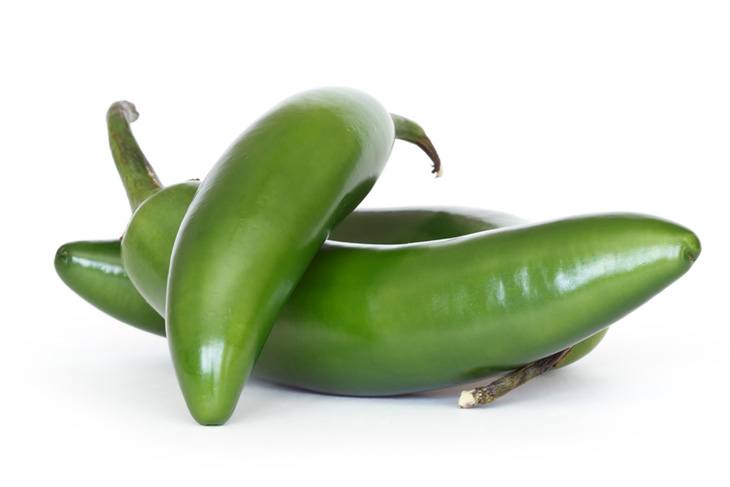
This pepper is among the oldest of Mexican ingredients, enjoying a dignified history. You can find traces of them within many of the most famous Mexican dishes.
The fiery Serrano chilies tend to have a fresher taste than the jalapenos, making them much better for garnishing. You can also use them as a substitute for green chili peppers in Greek salads or sandwiches, thanks to the same level of heat.
The most popular way that the Mexicans like to enjoy Serranos is to roast them slightly. Doing so will release the flavor hiding within the thick flesh of the pepper, providing an incredible snack. In this way, one can say that it can also be a substitute for jalapenos.
Serrano is a rich source of capsaicin, which can reduce and maintain the level of blood sugar. It is also capable of lowering the insulin production rate in women who have gestational diabetes.
8. Chili Powder
What we call chili powder is the pulverized and dried form of many chili pepper varieties. There are also traces of many other ingredients, of which the most common are salt, garlic powder, onion, and cumin. As a result, it can replace pretty any type of chili, and green chili is no exception.

One can say that this spice is among the oldest, as it has been around for thousands of years. You can find it in many old recipes, ranging from Chinese to Indian cooking. Each region has its unique chili pepper, but the core concept is always the same.
The most common description of chili powder’s taste is piquancy. To be more specific, it is sharper than the taste of green chili, but not by too much. That is specifically why we can use it to substitute green pepper in stews and roasts. It will serve as a much better stimulant if you put it in moderately.
No matter where it originates from, chili powder would always have capsaicin as its main component. Due to its potent inflammation inhibitor, capsaicin can treat diabetic neuropathy, psoriasis, and arthritis.
9. Red Chilies
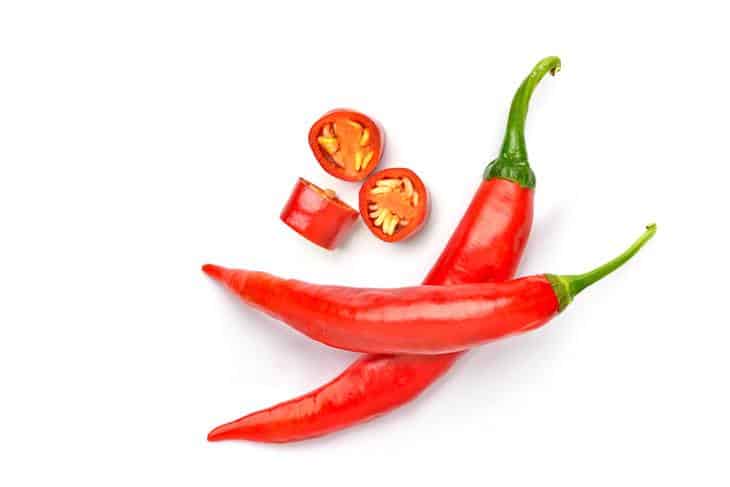
Of course, red chilies can substitute for green chili peppers; they are one and the same. The only difference is that red chilies are fully ripened ones so that you will have more heat. As such, as long as you can tolerate the much higher heat, you can use them for pretty much any recipe requiring green chillies.
For the most part, red chilies are much smaller than green chillies in size. This is a good thing, as the size shrinking means that the flavor will become deeper and deeper. A fully grown red chili packs a much stronger punch to your tongue than any green chili.
As mentioned above, red chilies are often much spicier than green ones, evident by their 30,000-50,000 Scoville spice levels. If you are not careful while adding them, you may end up wasting your meal. Our tip is to add about 1/3 of the green chili amount you would have added, even if it’s Indian cuisine.
Red chilies are a richer source of iron and oxygen than green chilies, both of which improve hemoglobin production and blood flow. For this reason, they can help tremendously in maintaining your cognitive performance.
10. Cayenne Pepper
Belonging in the same nightshade family as jalapenos and bell peppers, cayenne chili is famous for its spiciness. Cayenne peppers are generally at least 4 inches long, skinny, and mostly red in color. There hardly is any cayenne pepper with the color green.
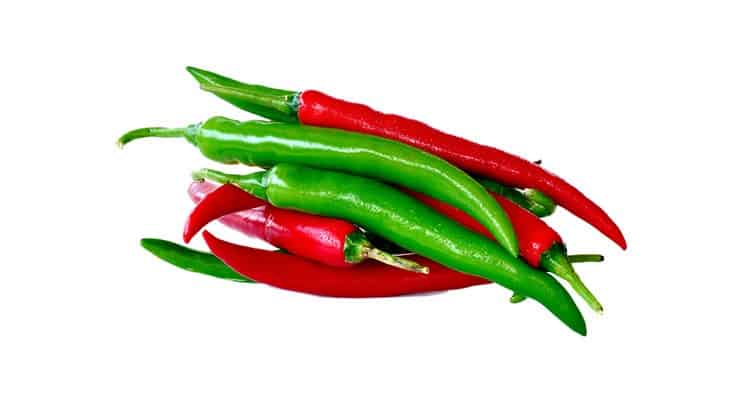
No matter where it comes from, cayenne pepper will always have a special “earthy-spicy” flavor. This flavor is so robust that it gives a noticeable kick of heat of a whole new level. It’s especially strong in the paste form. Ground cayenne pepper can send you to spicy heaven.
For this reason, we believe that it can serve as a good substitute for green chillies in dishes like curries. You do need to be careful, though, as this paste does have a 50,000 Scoville score. If you can’t handle spiciness well, it can prove to be too much for you.
High heat means a high concentration of capsaicin. As a result, your stomach will receive strong protection against ulcers. Capsaicin is, after all, able to limit the development of H. pylori, effectively eliminating any chance of inflammation.
11. Jwala Peppers

Despite having a name meaning “an intense flame” in Sanskrit, this pepper’s spiciness is on the milder side. Specifically, it is between Cayenne and Serrano in overall heat, about 10 times spicier than the jalapeno. This bit of heat makes it the singular most popular type of Indian pepper.
From its informal name, finger hot pepper, you can easily guess that it looks no different from a thin and curved finger. This grocery can grow up to four inches in length with wrinkled skin. While the red variant is certainly the most famous, the green one is no slouch, either.
These chilies have a specific fruity taste that reminds you of apples. With this taste, you can easily replace green pepper with them in dishes like salads or curries. The paste form will act as a better flavor enhancer than green chili and elevate your recipe even more.
Jwala pepper has a high concentration of capsaicin, known for its effectiveness against high blood pressure. If you can eat this pepper’s paste regularly in a moderate amount alongside a high-carb meal, your blood pressure level will normalize.
12. Bird’s Eye Chili
The bird-eye chili is a distinguished sub-species of the Capsicum annuum alongside aromatic pepper and sweet pepper. Due to this connection, bird’s eye chili has a distinctive taste that perfectly combines their strengths.
This type of chili has a special appearance, measuring only 2 inches in length and 1 inch in width. Each chili is round and small, reminding us of an eye. This common ingredient also relies on birds to spread its seed, providing the origin for the name.

With a heat level comparable to habanero, most wouldn’t expect this pepper as a green chili replacement. However, its fresh flavor makes it the perfect substitute, as long as you can tolerate the spiciness.
Our recommendation is to use them instead of green chilies for stews and curries. You may need some time for this chili’s flavor to seep through completely.
There are lots of antioxidants in this indispensable ingredient, which can help with cold symptoms, from sneezing to postnasal drip.
Green Chilies Substitute FAQ
Here are some interesting questions that we encountered while researching.
How Do You Lessen The Chilies’ Heat?
There are quite a lot of methods to lower the heat of the chili. For instance, the fastest way is to remove all ribs and seeds of the chilies before cooking.
If you have already started cooking and are close to finishing, consider adding some acids into the dish. Acids are amazingly good at cutting through the heat of chilies. You can use anything, ranging from lime juice to vinegar to tomato sauce.
The last resort is to serve some dairy products alongside your food. They will cool the heat down quickly.
How Do You Store Green Chilies?
The simplest method is to store them in zip lock bags, but you want to remove all the stem parts of the chilies. This method can keep your peppers fresh for about 7 days with the help of a fridge.
You can also try to freeze them with aluminum foil and put them in air-tight containers.
Conclusion
With this list, we hope that you can find the best green chilies substitute near your place. All you need to remember is that you don’t have to focus on one single ingredient. If push comes to shove, you can mix two or three kinds to create your own perfect green pepper replacement.
Thank you for reading and happy cooking!


